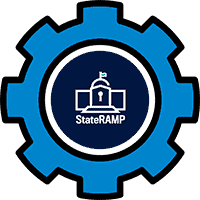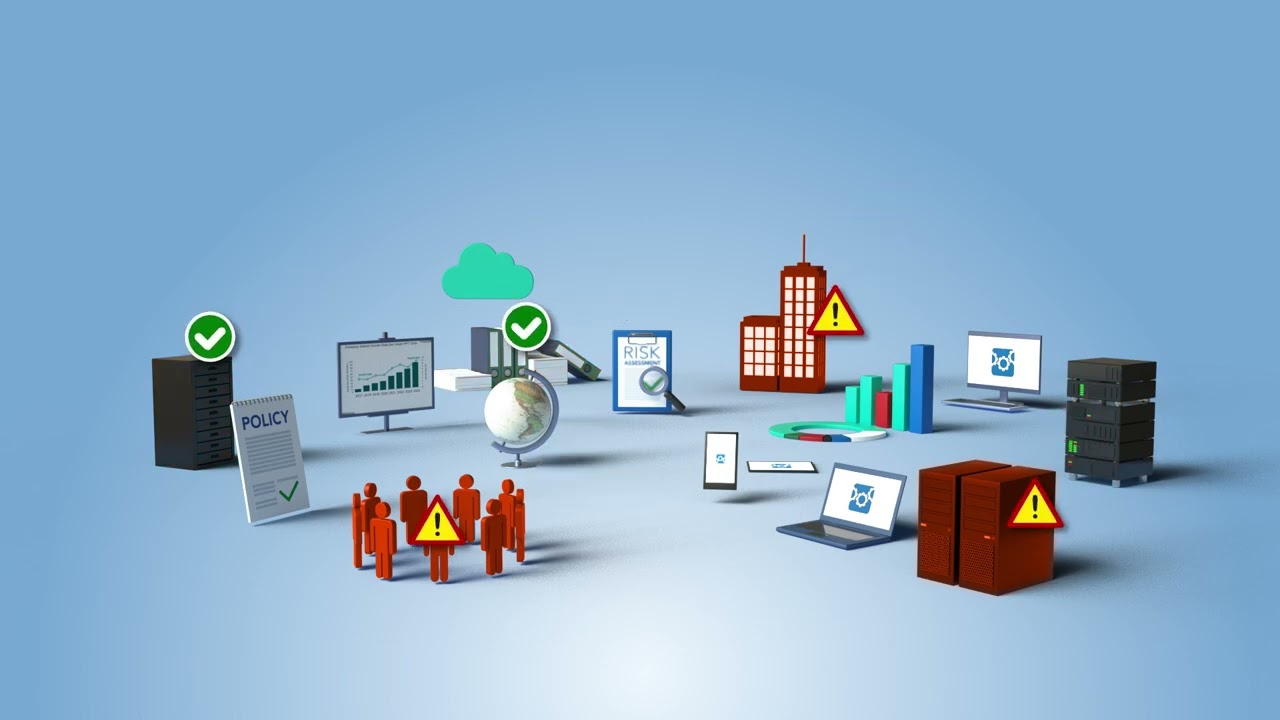Your Roadmap to Risk Reduction!
Table of Contents
ToggleThe Continuum GRC ITAM SaaS platform has hundreds of plugin modules available, such as:

GovRAMP
GovRAMP was developed with procurement and IT officials in mind – to bridge the gap between the two offices and provide a framework of cybersecurity standards for government contractors. All too often, procurement officials are challenged with procuring the best cloud services and software for the lowest price, without the tools or resources to verify cybersecurity compliance.
While state and local governments have begun to take steps to secure their own databases, not much has been done to validate the oversight and protection of third-party cloud service providers with whom they do business.
Modules include:
- System Security Plan (SSP) High-Moderate-Low
- System Security Plan (SSP)
- Security Assessment Report (SAR)
- Security Assessment Plan (SAP)
- Plan of Action and Milestones (POA&M)
- Customer Responsibility Matrix
- Electronic Authentication (E-Authentication) Plan
- Privacy Impact Assessment (PIA)
- Rules of Behavior (RoB)
- Information System Contingency Plan (ISCP)
- CIS for SSP Low, Moderate, or High Baselines
- Integrated Inventory Workbook
- Information System Security Policies and Procedures
- Configuration Management (CM) Plan
- Control Implementation Summary (CIS)
- CIS Worksheet
- IT Contingency Plan (CP)
- Incident Response Plan (IRP)
- Rules of Behavior (ROB)
- AC Access Control
- AT Awareness and Training
- AU Audit and Accountability
- CA Certification, Accreditation, and Security Assessment
- CM Configuration Management
- CP Contingency Planning
- IA Identification and Authentication
- IR Incident Response
- MA Maintenance
- MP Media Protection
- PE Physical and Environmental Protection
- PL Planning
- PS Personnel Security
- RA Risk Assessment
- SA System and Services Acquisition
- SC System and Communications Protection
- SI System and Information Integrity
- PM Project Management
ConMon
- Continuous Monitoring Activities & Deliverables: Continuous
- Continuous Monitoring Activities & Deliverables: Weekly
- Continuous Monitoring Activities & Deliverables: 10 days
- Continuous Monitoring Activities & Deliverables: Monthly
- Continuous Monitoring Activities & Deliverables: 60 days
- Continuous Monitoring Activities & Deliverables: Quarterly (90 days)
- Continuous Monitoring Activities & Deliverables: Annual
- Continuous Monitoring Activities & Deliverables: Every 2 years
- Continuous Monitoring Activities & Deliverables: Every 3 years
- Continuous Monitoring Activities & Deliverables: Every 5 years
- StateRAMP Significant Change Request Form
- StateRAMP Significant Change Request Form: Attachment A
Policies and Procedures
- AC – Access Control Policy
- AC – Access Control Procedure
- AT – Awareness & Training Policy
- AT – Awareness & Training Procedure
- AU – Audit & Accountability Policy
- AU – Audit & Accountability Procedure
- CA – Security Assessment and Authorization Policy
- CA – Security Assessment and Authorization Procedure
- CM – Configuration Management Policy
- CM – Configuration Management Procedure
- CP – Contingency Planning Policy
- CP – Contingency Planning Procedure
- IA – Identification & Authentication Policy
- IA – Identification & Authentication Procedure
- IR – Incident Response Policy
- IR – Incident Response Procedure
- MA – Maintenance Policy
- MA – Maintenance Procedure
- MP – Media Protection Policy
- MP – Media Protection Procedure
- PE – Physical & Environmental Policy
- PE – Physical & Environmental Procedure
- PL – Planning Policy
- PL – Planning Procedure
- PS – Personnel Policy
- PS – Personnel Procedure
- RA – Risk Assessment Policy
- RA – Risk Assessment Procedure
- SA – System & Services Acquisition Policy
- SA – System & Services Acquisition Procedure
- SC – System & Communications Protection Policy
- SC – System & Communications Protection Procedure
- SI – System & Information Integrity Policy
- SI – System & Information Integrity Procedure
Key Components of GovRAMP Assessment
This form of cybersecurity evaluation was designed to ensure that cloud service providers that work with state and local governments meet specific standards when dealing with the security of sensitive data. GovRAMP is modeled after FedRAMP, the cloud security standards required by the federal government.
A third-party assessment begins with reviewing the key assets of the organization and prioritizing their value to the business. These range from security gap analysis, data collection, general cloud security, employee training, and more.
Changes are recommended to meet the security compliance standards, and continuous monitoring is established to maintain them. Thorough documentation is also required.
GovRAMP Assessment Process
Some initial research is first required to understand the GovRAMP requirements. Finding a third-party assessor like Continuum GRC can smooth the process. There’s a readiness assessment, which is optional, but it will better help identify security gaps for compliance that need to be addressed.
There are various report levels that need to be addressed, detailing specific security controls and procedures, plans of action, secure cloud services, and the like. Extensive documentation is also required, followed by an executive summary for review by the government. An experienced third-party assessor can expertly navigate your organization through this complex path to achieve this important certification.
Why Choose US?
Continuum GRC has years of experience working through the evolving requirements for high-level certifications. We know and understand the small details that can throw off the process and slow it down. We get ahead of those things to keep it all moving forward.
Any kind of certification or compliance program that touches on the government necessarily demands exceptional thoroughness and care. We have the expertise to assess where you are, make sensible recommendations, help you implement them, and then assist in the required monitoring and needed documentation. Going it alone is costly, time-consuming, and eats up resources. Let us handle it.
FAQ
Who needs to obtain StateRAMP certification?
Any cloud service provider who works with (or hopes to work with) state and local governments must align with these particular cybersecurity standards. It boils down to ensuring that any official or employee with responsibility for the security of information or IT related to government resources must achieve this form of certification.
What are the steps to achieve StateRAMP compliance?
Select the right authorization path for your organization. Choose an authorized third-party auditor like Continuum GRC to oversee the assessment. Gather documentation – policies, plans, and procedures related to information security. Let your third-party assessor conduct the assessment for compliance against StateRAMP requirements. Submit the package for certification, and maintain compliance with regular assessments.
How long does the StateRAMP compliance process take?
The StateRAMP compliance process takes about three to six months. It includes completing the application and all required documentation, undergoing a security assessment and remediating any issues that have been reported. Some state and local organizations who need moderate or high authorization can do a fast-track process of one to two months.
Does Continuum GRC help with the full StateRAMP process?
As experts in all kinds of certifications, Continuum GRC helps organizations and service providers move through what can be a complicated process. We know the documentation required, how to run an efficient assessment and implement needed fixes. We also understand how to institute the monitoring processes to ensure that you remain in compliance.
What is a Third-Party Assessment Organization (3PAO)?
A third-party assessment organization is one that has been authorized to guide an organization – whether public or private – through the needed tests and reviews to achieve certifications of all kinds. Continuum GRC has a deep understanding of the ins and outs of various high-level security checks.
What is the difference between StateRAMP and FedRAMP?
These are both cybersecurity frameworks for handling sensitive information. StateRAMP are guidelines for use in local and state governments; FedRAMP is for use at the federal level. FedRAMP compliance is mandatory by the General Services Administration, while StateRAMP criteria is voluntary, managed by individual states.
What are you waiting for?
You are just a conversation away from putting the power of Continuum GRC to work for you.
Contact us using the form below or calling us at 1-888-896-6207 for immediate assistance.
To reduce spam submissions, we’ve implemented email verification for access to this form.
How it works:
- Enter your email address below.
- We'll send you a unique verification link.
- Click the link in the email to confirm your identity and gain access to the form.
This ensures only verified users can proceed, helping keep responses genuine and spam-free.
Thank you for your cooperation! If you don't receive the email, check your spam folder or request a new link. If you prefer to speak with a REAL HUMAN, please call our number listed at the top of this page.
About the Standard
GovRAMP, formerly known as StateRAMP, is a nonprofit organization designed to standardize and streamline cybersecurity compliance for cloud service providers (CSPs) serving state, local, tribal, and educational (SLTT) government entities. Modeled after the federal FedRAMP program, GovRAMP provides a unified framework for assessing, authorizing, and continuously monitoring cloud services to ensure robust security for government data. Below is a comprehensive overview of GovRAMP compliance, including its purpose, key components, requirements, and processes.
Purpose of GovRAMP
GovRAMP aims to simplify cybersecurity compliance for CSPs and government agencies by:
- Standardizing security assessment processes to reduce redundancy.
- Providing a “verify once, serve many” model, allowing CSPs to achieve compliance once and serve multiple government entities.
- Protecting sensitive government data and critical infrastructure.
- Facilitating secure cloud adoption for state and local governments.
- Reducing compliance burdens and costs for both CSPs and government agencies.
It was rebranded from StateRAMP to GovRAMP in February 2025 to reflect its broader mission of unifying cybersecurity standards across various government levels, including state, local, tribal, and educational institutions. As of April 2025, over two dozen states and public education institutions, such as Alabama, Arizona, California, and others, have adopted GovRAMP.
Key Components of GovRAMP Compliance
- NIST 800-53 Framework:
- GovRAMP is built on the National Institute of Standards and Technology (NIST) Special Publication 800-53 Revision 5, which provides a comprehensive catalog of security and privacy controls.
- It covers approximately 380 of the 420 NIST 800-53 controls, tailored to address cloud-specific security needs for state and local governments.
- The framework ensures protection against cyber threats, insider threats, and data breaches while maintaining data privacy, especially for personally identifiable information (PII).
- Impact Levels:
- GovRAMP categorizes cloud services based on data sensitivity and system criticality into four impact levels:
- Low: Publicly available, non-sensitive data with basic controls.
- Low+: Limited sensitive data with enhanced controls (Low-Moderate hybrid).
- Moderate: Confidential data and critical systems requiring comprehensive controls.
- High: Sensitive and critical systems with stringent controls, equivalent to FedRAMP High.
- CSPs must align their security controls with the appropriate impact level based on a risk assessment and data classification, often using GovRAMP’s Data Classification Tool.
- GovRAMP categorizes cloud services based on data sensitivity and system criticality into four impact levels:
- Third-Party Assessment Organizations (3PAOs):
- Compliance requires independent audits by accredited 3PAOs, which validate and verify security controls.
- 3PAOs conduct vulnerability scans, penetration testing, and in-depth security control reviews, producing key documents like the Security Assessment Report (SAR).
- Continuous Monitoring:
- Continuous monitoring is a cornerstone of GovRAMP compliance, ensuring ongoing security through:
- Monthly vulnerability scans and reports.
- Annual assessments by 3PAOs.
- Incident reporting and remediation plans (Plan of Actions and Milestones, POA&M).
- This ensures CSPs maintain compliance and adapt to evolving threats.
- Continuous monitoring is a cornerstone of GovRAMP compliance, ensuring ongoing security through:
- Security Statuses:
- GovRAMP assigns statuses to CSPs based on their compliance progress, listed on the Authorized Product List (APL):
- Verified Offerings:
- Core: Meets 60 moderate-level NIST 800-53 controls (introduced May 2025), ideal for newer or smaller providers. Requires quarterly monitoring.
- Ready: Meets minimum security requirements with 3PAO assessment.
- Provisional: Exceeds minimum requirements and includes a government sponsor.
- Authorized: Fully compliant with all required controls, government sponsor, and ongoing monitoring.
- Progressing Offerings:
- Active: Working toward Ready status.
- In Process: Working toward Authorized status.
- Pending: Security package submitted, awaiting PMO review.
- Verified Offerings:
- Authorized and Provisional statuses require a government sponsor, though the GovRAMP Approvals Committee can act as a sponsor if needed.
- GovRAMP assigns statuses to CSPs based on their compliance progress, listed on the Authorized Product List (APL):
Authorization Process
The GovRAMP authorization process involves several steps to ensure CSPs meet security standards:
- Become a GovRAMP Member: CSPs must join GovRAMP to access resources and initiate the process.
- Complete a Security Snapshot: An initial self-assessment to evaluate the CSP’s security posture.
- Identify Impact Level and Desired Status: Determine the appropriate impact level (Low, Low+, Moderate, High) and target status (e.g., Ready, Authorized).
- Select a 3PAO: Engage an accredited 3PAO for independent validation.
- Prepare Documentation: Key documents include:
- System Security Plan (SSP): Details the system’s security controls and architecture.
- Security Assessment Report (SAR): Evaluates security control effectiveness.
- Plan of Actions and Milestones (POA&M): Outlines remediation for identified gaps.
- Readiness Assessment Report (RAR): Confirms readiness for formal assessment.
- Security Controls Matrix: Maps controls to NIST 800-53 requirements.
- Submit Security Review Request: The security package is submitted to the GovRAMP Program Management Office (PMO) for review.
- Continuous Monitoring: Post-authorization, CSPs must maintain compliance through regular monitoring and reporting.
Differences Between GovRAMP and FedRAMP
While GovRAMP mirrors FedRAMP, key differences include:
- Scope: GovRAMP focuses on state, local, tribal, and educational entities, while FedRAMP targets federal agencies.
- Sponsorship: GovRAMP allows authorization without a government sponsor (via the Approvals Committee), unlike FedRAMP, which requires a federal agency sponsor.
- Flexibility: GovRAMP offers more flexible compliance pathways and is considered more cost-effective and agile.
- Fast Track: CSPs with FedRAMP Ready status can bypass certain GovRAMP audit steps, expediting authorization.
Benefits of GovRAMP Compliance
- Enhanced Credibility: Inclusion on the Authorized Product List boosts trust among government clients, partners, and stakeholders.
- Stronger Security Posture: NIST 800-53 controls protect against cyber threats, reducing risks of breaches and data loss.
- Cost Savings: Standardized compliance reduces redundant assessments, saving time and resources.
- Improved Procurement Efficiency: Governments can procure services faster with pre-verified CSPs.
- Cross-Framework Alignment: GovRAMP overlaps with FedRAMP, SOC 2, and ISO 27001, facilitating compliance with multiple standards.
- Support for AI Security: In April 2025, GovRAMP launched an AI Security Task Force to address cybersecurity risks in AI-enabled cloud services.
Compliance Challenges
- Documentation Burden: Preparing comprehensive documents like SSPs and SARs is time-consuming and resource-intensive.
- Cost and Time: Achieving compliance, especially for higher impact levels, can take 6–24 months and requires significant investment.
- Continuous Monitoring: Ongoing assessments and reporting demand sustained effort and resources.
- Varying State Requirements: While GovRAMP standardizes processes, some states may have unique requirements, adding complexity.
GovRAMP Core: A New Compliance Path
Introduced in May 2025, GovRAMP Core is a lighter compliance option for newer or smaller CSPs. It requires meeting 60 moderate-level NIST 800-53 controls and quarterly monitoring, serving as an intermediate step toward full authorization. This makes compliance more accessible while maintaining robust security standards.
Practical Steps for Compliance
- Assess Data Sensitivity: Use GovRAMP’s Data Classification Tool to determine the appropriate impact level.
- Engage a 3PAO Early: Partner with an accredited 3PAO to guide the assessment process.
- Develop Robust Documentation: Invest in creating detailed SSPs, SARs, and POA&Ms to demonstrate compliance.
- Implement NIST Controls: Align systems with NIST 800-53 controls, focusing on the relevant impact level.
- Plan for Continuous Monitoring: Establish processes for monthly scans, annual assessments, and incident response.
- Leverage Fast Track (if applicable): CSPs with FedRAMP authorization can use the Fast Track program to expedite GovRAMP compliance.
Conclusion
GovRAMP provides a structured, NIST-based framework to ensure secure cloud services for state and local governments. By standardizing security assessments, requiring 3PAO audits, and enforcing continuous monitoring, it enhances trust and efficiency in government procurement. CSPs achieving GovRAMP compliance gain a competitive edge in the SLTT market, while governments benefit from stronger cybersecurity and streamlined processes. For detailed guidance, CSPs and agencies can refer to resources on the official GovRAMP website (govramp.org) or consult with compliance experts like Continuum GRC or Lazarus Alliance.
azing Benefits

